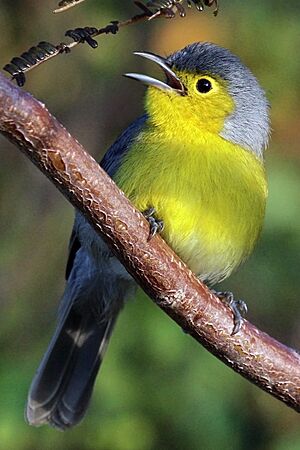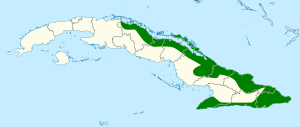Oriente warbler facts for kids
Quick facts for kids Oriente warbler |
|
|---|---|
 |
|
| Cayo Romano, Cuba | |
| Conservation status | |
| Scientific classification | |
| Genus: |
Teretistris
|
| Species: |
fornsi
|
 |
|
| Range of T. fornsi | |
The Oriente warbler (Teretistris fornsi) is a small bird that lives only in Cuba. It is one of two types of birds in a special family called the Teretistridae. You can find this bird in central and eastern parts of Cuba.
Contents
How Scientists Classify the Oriente Warbler
The Oriente warbler belongs to the same family and group (genus) as the yellow-headed warbler. For a long time, scientists thought these birds were part of a larger group called New World warblers. However, after studying their DNA, scientists learned that the Cuban warblers are unique. In 2017, they were given their own special family. Their closest bird relatives include the Spindalidae family, the yellow-breasted chat, and the Icteridae family (which includes New World blackbirds).
There are two slightly different kinds, or subspecies, of the Oriente warbler: the main one, called T. f. fornsi, and another one called T. f. turquinensis.
What the Oriente Warbler Looks Like
The Oriente warbler is about 13 cm (5.1 in) long. It weighs between 7.4 to 13 g (0.26 to 0.46 oz), which is about as much as a few paper clips.
The main subspecies, T. f. fornsi, has a gray head, neck, and back. Its face, throat, and most of its chest and belly are bright yellow. The very bottom of its belly is white, and its sides have a light brownish color.
The subspecies T. f. turquinensis is a bit bigger. Its head and back are a darker, sooty gray. The brownish color on its sides is more gray instead.
Where the Oriente Warbler Lives and Its Home
The main subspecies of the Oriente warbler lives in the mountains and along the coast of eastern Cuba. It also lives on the islands off Cuba's north coast, known as the Sabana-Camagüey Archipelago. The T. f. turquinensis subspecies is found in the Sierra Maestra mountains, which are along the southeastern coast of Cuba.
This bird can live in many different kinds of forests. It likes places where the plants on the forest floor are mostly untouched. It also lives in bushy, scrubby areas that are drier. You can find it from sea level all the way up to almost 2,000 m (6,600 ft) high in the mountains. It often prefers dry, scrubby woodlands near the coast and more humid forests at higher elevations.
Oriente Warbler Behavior
Movement and Migration
The Oriente warbler stays in the same area all year long. It does not migrate to other places.
How the Oriente Warbler Finds Food
The Oriente warbler looks for food from the ground up to the middle parts of the forest. It mainly picks insects off leaves and branches. It also hovers to snatch food or pokes into tree bark and dead leaves. Its favorite food is beetles, but it also eats other insects, small creatures without backbones, tiny lizards, and possibly small fruits.
When it's not breeding, Oriente warblers often gather in groups of up to 15 birds. These groups can sometimes join other types of birds to form larger feeding groups.
Oriente Warbler Reproduction
The Oriente warbler's breeding season is from March to July. They usually lay their eggs in March and April.
They build their nests using moss, grass, small roots, and other plant fibers. The nest is often placed in a clump of Tillandsia (a plant that grows on other plants) about 1 m (3 ft) high on a branch or in a fork of a tree. A female bird usually lays two or three eggs. The eggs hatch after eight or nine days. The young birds are ready to leave the nest about 10 to 11 days after they hatch.
Oriente Warbler Sounds
The Oriente warbler's song is described as "a series of buzzy notes mixed with sweeter notes." It also makes a sharp "tchip" sound as a call.
Oriente Warbler Conservation Status
The IUCN (International Union for Conservation of Nature) has listed the Oriente warbler as a species of "Least Concern." This means that it is not currently in danger of disappearing. Even though it lives in a small area, its population size is believed to be stable. There are no immediate threats that scientists have found. It is likely a common bird within its specific, though sometimes spread-out, home range.
See also
 In Spanish: Teretistris fornsi para niños
In Spanish: Teretistris fornsi para niños


